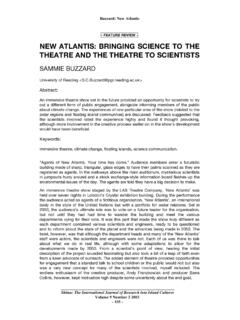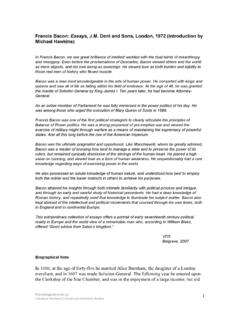Transcription of Sexuality and Gender - Clare Boothe Luce Policy Institute Home
1 ~ Special Report ~ Sexuality and GenderFindings from the Biological, Psychological, and Social SciencesLawrence S. Mayer, , , Paul R. McHugh, 50 ~ Fall 2016 ~ $ 2016 ~ Copyright 2016. All rights reserved. See for more report presents a careful summary and an up-to-date explanation of research from the biological, psychological, and social sciences related to sexual orientation and Gender identity. It is offered in the hope that such an exposition can contribute to our capacity as physicians, scientists, and citizens to address health issues faced by LGBT populations within our key findings:Part One: Sexual Orientation The understanding of sexual orientation as an innate, biologi-cally fixed property of human beings the idea that people are born that way is not supported by scientific evidence.
2 While there is evidence that biological factors such as genes and hormones are associated with sexual behaviors and attrac-tions, there are no compelling causal biological explanations for human sexual orientation. While minor differences in the brain structures and brain activity between homosexual and heterosexual individuals have been identified by researchers, such neurobiological findings do not demonstrate whether these differences are innate or are the result of environmental and psychological factors. Longitudinal studies of adolescents suggest that sexual ori-entation may be quite fluid over the life course for some people, with one study estimating that as many as 80% of male adoles-cents who report same-sex attractions no longer do so as adults (although the extent to which this figure reflects actual changes in same-sex attractions and not just artifacts of the survey pro-cess has been contested by some researchers).
3 Compared to heterosexuals, non-heterosexuals are about two to three times as likely to have experienced childhood sexual Summary ~ The New AtlantisExecutive SummaryCopyright 2016. All rights reserved. See for more Two: Sexuality , Mental Health Outcomes, and Social Stress Compared to the general population, non-heterosexual sub-populations are at an elevated risk for a variety of adverse health and mental health outcomes. Members of the non-heterosexual population are estimated to have about times higher risk of experiencing anxiety dis-orders than members of the heterosexual population, as well as roughly double the risk of depression, times the risk of sub-stance abuse, and nearly times the risk of suicide. Members of the transgender population are also at higher risk of a variety of mental health problems compared to members of the non-transgender population.
4 Especially alarmingly, the rate of lifetime suicide attempts across all ages of transgender indi-viduals is estimated at 41%, compared to under 5% in the overall population. There is evidence, albeit limited, that social stressors such as discrimination and stigma contribute to the elevated risk of poor mental health outcomes for non-heterosexual and transgender populations. More high-quality longitudinal studies are neces-sary for the social stress model to be a useful tool for under-standing public health Three: Gender Identity The hypothesis that Gender identity is an innate, fixed prop-erty of human beings that is independent of biological sex that a person might be a man trapped in a woman s body or a woman trapped in a man s body is not supported by scientific evidence. According to a recent estimate, about of adults iden-tify as a Gender that does not correspond to their biological sex.
5 Studies comparing the brain structures of transgender and non-transgender individuals have demonstrated weak correla-tions between brain structure and cross- Gender identification. These correlations do not provide any evidence for a neurobio-logical basis for cross- Gender 2016 ~ Executive SummaryCopyright 2016. All rights reserved. See for more information. Compared to the general population, adults who have under-gone sex-reassignment surgery continue to have a higher risk of experiencing poor mental health outcomes. One study found that, compared to controls, sex-reassigned individuals were about 5 times more likely to attempt suicide and about 19 times more likely to die by suicide. Children are a special case when addressing transgender issues. Only a minority of children who experience cross- Gender identi-fication will continue to do so into adolescence or adulthood.
6 There is little scientific evidence for the therapeutic value of interventions that delay puberty or modify the secondary sex characteristics of adolescents, although some children may have improved psychological well-being if they are encouraged and supported in their cross- Gender identification. There is no evi-dence that all children who express Gender -atypical thoughts or behavior should be encouraged to become ~ The New AtlantisCopyright 2016. All rights reserved. See for more , replicable scientific research results can and do influence our personal decisions and self-understanding, and can contribute to the pub-lic discourse, including cultural and political debates. When the research touches on controversial themes, it is particularly important to be clear about precisely what science has and has not shown.
7 For complex, compli-cated questions concerning the nature of human Sexuality , there exists at best provisional scientific consensus; much remains unknown, as Sexuality is an immensely complex part of human life that defies our attempts at defining all its aspects and studying them with questions that are easier to study empirically, however, such as those concerning the rates of mental health outcomes for identifiable subpopulations of sexual minorities, the research does offer some clear answers: these subpopulations show higher rates of depression, anxiety, substance abuse, and suicide compared to the general population. One hypothesis, the social stress model which posits that stigma, prejudice, and discrimination are the primary causes of higher rates of poor mental health outcomes for these subpopulations is frequently cited as a way to explain this disparity.
8 While non-heterosexual and transgender individu-als are often subject to social stressors and discrimination, science has not shown that these factors alone account for the entirety, or even a major-ity, of the health disparity between non-heterosexual and transgender subpopulations and the general population. There is a need for extensive research in this area to test the social stress hypothesis and other poten-tial explanations for the health disparities, and to help identify ways of addressing the health concerns present in these of the most widely held views about sexual orientation, such as the born that way hypothesis, simply are not supported by science. The literature in this area does describe a small ensemble of biological differenc-es between non-heterosexuals and heterosexuals, but those biological dif-ferences are not sufficient to predict sexual orientation, the ultimate test of any scientific finding.
9 The strongest statement that science offers to explain sexual orientation is that some biological factors appear, to an unknown extent, to predispose some individuals to a non-heterosexual suggestion that we are born that way is more complex in the case of Gender identity. In one sense, the evidence that we are born with ConclusionFall 2016 ~ 115 ConclusionCopyright 2016. All rights reserved. See for more given Gender seems well supported by direct observation: males over-whelmingly identify as men and females as women. The fact that children are (with a few exceptions of intersex individuals) born either biologically male or female is beyond debate. The biological sexes play complementary roles in reproduction, and there are a number of population-level average physiological and psychological differences between the sexes.
10 However, while biological sex is an innate feature of human beings, Gender identity is a more elusive reviewing the scientific literature, we find that almost nothing is well understood when we seek biological explanations for what causes some individuals to state that their Gender does not match their biological sex. The findings that do exist often have sample-selection problems, and they lack longitudinal perspective and explanatory power. Better research is needed, both to identify ways by which we can help to lower the rates of poor mental health outcomes and to make possible more informed discus-sion about some of the nuances present in this despite the scientific uncertainty, drastic interventions are pre-scribed and delivered to patients identifying, or identified, as transgender. This is especially troubling when the patients receiving these interven-tions are children.










